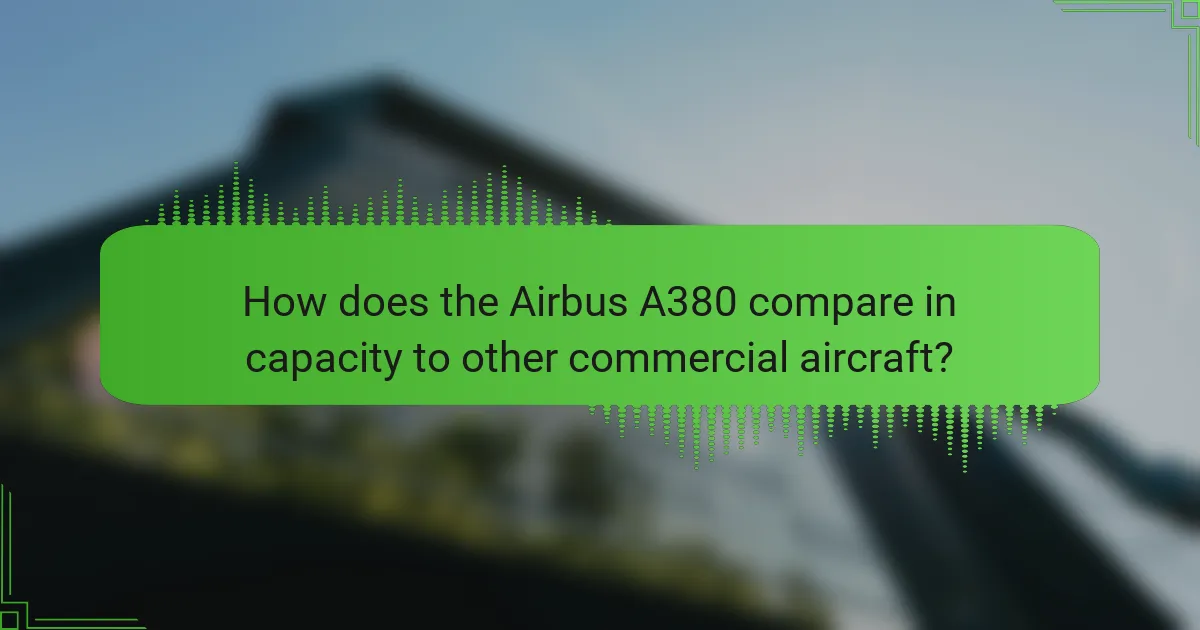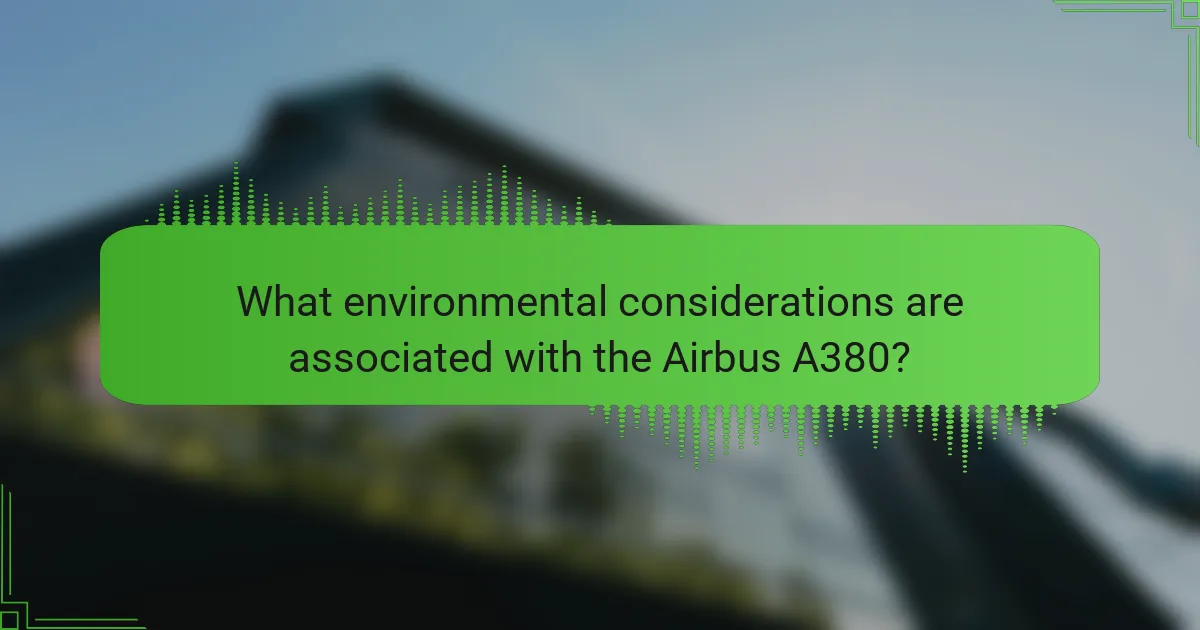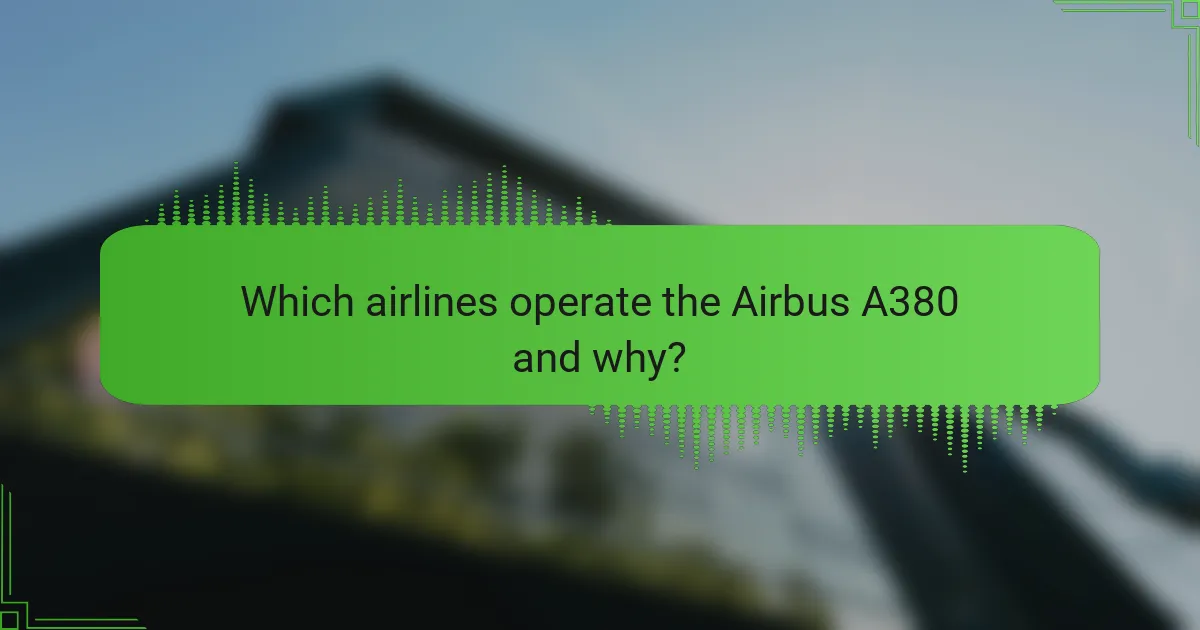The Airbus A380 stands out as a pinnacle of modern aviation, offering unparalleled passenger capacity and advanced engineering. Key innovations include its double-deck design and fuel-efficient engines. Environmental considerations highlight its reduced emissions and noise pollution. Airlines leverage the A380 for high-capacity routes, ensuring a luxurious and sustainable travel experience.

What are the key engineering innovations of the Airbus A380?
The key engineering innovations of the Airbus A380 include its double-deck design, advanced materials, and fuel-efficient engines. The A380’s unique structure allows for a passenger capacity of up to 850, making it the largest passenger aircraft. Its composite materials reduce weight while enhancing strength. Additionally, the A380 features environmentally friendly technologies, such as quieter engines and improved aerodynamics, contributing to lower emissions. These innovations set the A380 apart as a leader in modern aviation.
How do these innovations enhance passenger experience?
Innovations in the Airbus A380 significantly enhance passenger experience through advanced comfort, connectivity, and environmental efficiency. Features like spacious cabins, quieter engines, and improved air quality contribute to a more enjoyable flight. The A380’s innovative design allows for greater passenger capacity while maintaining comfort levels. Enhanced in-flight entertainment systems provide a wider selection of media, ensuring passengers remain engaged throughout their journey. Additionally, the aircraft’s fuel-efficient engines reduce environmental impact, aligning with modern sustainability expectations.
What role does aerodynamics play in the A380’s design?
Aerodynamics significantly influences the Airbus A380’s design, enhancing efficiency and stability. The aircraft’s shape reduces drag, allowing for smoother flight and lower fuel consumption. Features like winglets optimize airflow, improving lift and overall performance. These aerodynamic considerations contribute to the A380’s unique ability to carry more passengers while minimizing environmental impact.

How does the Airbus A380 compare in capacity to other commercial aircraft?
The Airbus A380 has a maximum capacity of 850 passengers in an all-economy configuration, surpassing other commercial aircraft. In comparison, the Boeing 747-8 can carry up to 660 passengers, while the Boeing 777-300ER accommodates around 550. The A380’s unique double-deck design contributes significantly to its passenger capacity. Additionally, the A380’s spacious cabin design enhances passenger comfort, a rare attribute among large aircraft.
What is the maximum passenger capacity of the A380?
The Airbus A380 has a maximum passenger capacity of 850 in an all-economy configuration. Typically, it accommodates around 555 passengers in a three-class setup. This aircraft is renowned for its spaciousness and efficiency, making it a preferred choice for long-haul flights.
How does cargo capacity influence airline operations?
Cargo capacity significantly influences airline operations by determining load factors, route planning, and profitability. For instance, the Airbus A380, with its substantial capacity, allows airlines to optimize flights on high-demand routes. This aircraft can carry up to 850 passengers or a significant amount of cargo, enhancing revenue potential. Additionally, larger capacities can lead to lower operational costs per seat, improving overall efficiency. Airlines can adjust their strategies based on cargo needs, impacting schedule frequency and fleet utilization.

What environmental considerations are associated with the Airbus A380?
The Airbus A380 has significant environmental considerations, particularly regarding fuel efficiency and noise reduction. It features advanced aerodynamics and lightweight materials that improve fuel consumption by approximately 20% compared to earlier models. The aircraft’s quieter engines contribute to reduced noise pollution, benefiting communities near airports. Additionally, Airbus aims to enhance sustainability through the use of sustainable aviation fuels, which can further lower carbon emissions. These factors position the A380 as a more environmentally friendly option in commercial aviation.
How does the A380’s fuel efficiency measure up?
The Airbus A380’s fuel efficiency is competitive, averaging 3.1 litres per 100 passenger kilometres. This efficiency results from its advanced aerodynamics and lightweight materials. Compared to other large aircraft, the A380 offers superior capacity with reduced environmental impact. Its unique four-engine design allows for optimal performance across various flight conditions, contributing to its overall efficiency.
What are the noise pollution levels of the A380 compared to other aircraft?
The Airbus A380 generates lower noise pollution levels compared to many other aircraft. It operates at approximately 75-80 decibels during takeoff, which is quieter than older models like the Boeing 747, typically exceeding 85 decibels. The A380’s advanced technology, including quieter engines and improved aerodynamics, contributes to its reduced noise footprint. This makes it a more environmentally considerate option for urban airports.

Which airlines operate the Airbus A380 and why?
Airlines operating the Airbus A380 include Emirates, Singapore Airlines, and British Airways. These airlines utilize the A380 for its high capacity and efficiency, accommodating up to 850 passengers in a single configuration. The aircraft’s advanced engineering allows for reduced fuel consumption per passenger, making it an environmentally friendly choice for long-haul flights. Emirates leads in A380 operations, showcasing its commitment to luxury travel and high passenger volume.
What factors influence an airline’s decision to use the A380?
Airlines consider several factors when deciding to use the Airbus A380. Key influences include passenger demand, operational efficiency, and environmental impact.
Airlines assess market demand for high-capacity flights, especially on popular routes. The A380’s capacity of up to 850 passengers allows airlines to maximize revenue on busy routes. Additionally, operational efficiency plays a role; the A380’s fuel efficiency compared to similar aircraft can lead to lower operating costs.
Environmental considerations are increasingly important. The A380’s advanced aerodynamics and engine technology reduce emissions per passenger, aligning with airlines’ sustainability goals.
In summary, airlines weigh passenger demand, operational efficiency, and environmental impact when choosing the A380, ensuring it fits their strategic objectives.
How does the A380 fit into the fleet strategies of major airlines?
The Airbus A380 fits into the fleet strategies of major airlines by enhancing capacity and operational efficiency. Its ability to carry up to 850 passengers allows airlines to maximize revenue on high-demand routes. Additionally, the A380’s advanced engineering contributes to lower per-seat fuel consumption, aligning with environmental goals. Airlines can leverage this aircraft to improve profitability while addressing sustainability concerns, making it a strategic asset in their fleets.

What are the maintenance requirements for the Airbus A380?
The Airbus A380 requires regular maintenance checks, including daily inspections, weekly checks, and comprehensive checks every 6, 12, and 24 months. Maintenance intervals are crucial for safety and efficiency. The aircraft’s size demands specialized facilities and trained personnel. Key tasks include engine overhauls, systems checks, and cabin maintenance. Each A380 undergoes about 1,500 maintenance tasks during its lifecycle, ensuring operational reliability.
How do maintenance costs compare with other aircraft types?
Maintenance costs for the Airbus A380 are generally higher than for smaller aircraft types. This is due to its size, complexity, and the advanced technology used in its design. The A380’s maintenance costs can exceed $20,000 per flight hour, significantly more than the $5,000 to $15,000 range typical for narrow-body aircraft. The larger size also means more extensive checks and repairs, contributing to these elevated expenses. As a result, airlines must carefully consider operational efficiency when integrating the A380 into their fleets.
What unique challenges do technicians face when servicing the A380?
Technicians face unique challenges when servicing the Airbus A380 due to its size and complexity. The aircraft’s extensive systems require specialized knowledge and tools. Accessing components in tight spaces complicates maintenance tasks. Additionally, the A380’s advanced technology demands continuous training for technicians. The sheer scale of the aircraft also impacts logistics, as parts must be transported efficiently.

How does passenger experience differ on the Airbus A380?
Passenger experience on the Airbus A380 is notably enhanced by its spacious design and advanced amenities. The aircraft features wider seats, higher ceilings, and quieter cabins compared to smaller models.
Passengers benefit from various seating configurations, allowing for more legroom and comfort. The A380 also offers innovative features like onboard lounges and bars, which significantly improve social interaction during flights.
In terms of environmental considerations, the A380 is designed for fuel efficiency, reducing carbon emissions per passenger. This aspect appeals to environmentally conscious travellers.
Overall, the Airbus A380 provides a unique flying experience characterized by luxury, comfort, and sustainability.
What amenities and features are unique to the A380?
The Airbus A380 features unique amenities such as spacious cabins, onboard lounges, and advanced entertainment systems. Its two full-length passenger decks enhance capacity, accommodating up to 850 passengers in an all-economy configuration. The aircraft also includes quieter engines, contributing to a more comfortable flight experience. Additionally, the A380’s unique wing design improves aerodynamics, resulting in better fuel efficiency.
How does seating configuration impact comfort and space?
Seating configuration significantly impacts comfort and space in the Airbus A380. The aircraft’s unique double-deck design allows for various seating layouts, enhancing passenger experience. Wider aisles and more spacious seating arrangements contribute to overall comfort, accommodating diverse passenger needs. Additionally, the cabin’s height creates a sense of openness, reducing feelings of confinement during flights. This design flexibility enables airlines to optimize configurations for business and economy classes, balancing capacity with passenger comfort.

What are the future prospects for the Airbus A380?
The future prospects for the Airbus A380 remain positive despite its production ending. Airlines are increasingly recognizing its efficiency in high-capacity routes. The A380’s unique feature is its ability to seat over 500 passengers, making it ideal for busy international travel. As a result, many operators are focusing on sustainability by retrofitting the aircraft with modern technologies to reduce emissions and enhance fuel efficiency. Additionally, the demand for premium travel experiences supports the continued relevance of the A380 in the aviation market.
How is the demand for the A380 evolving in the aviation market?
The demand for the Airbus A380 is evolving as airlines reassess their fleet strategies. While the A380 offers exceptional capacity and comfort, its operational costs and environmental impact are leading to a decline in orders. Airlines are increasingly favouring smaller, more fuel-efficient aircraft that can operate on a wider range of routes. As a result, the A380 may become a niche option for select markets rather than a mainstream choice. The unique attribute of its double-deck design continues to appeal to some operators, particularly for high-density routes.
What are the implications of the A380’s retirement for airlines?
The retirement of the Airbus A380 will significantly impact airlines by reducing capacity and altering route strategies. Airlines will need to adapt to shifts in passenger demand and operational efficiency. The A380, known for its unique capacity of up to 850 passengers, allowed airlines to maximize high-demand routes. Its retirement may lead to a greater reliance on smaller, more fuel-efficient aircraft, which could enhance environmental sustainability. Airlines will also need to consider fleet diversification and investment in new technology to remain competitive in a changing market landscape.
What best practices should airlines follow when operating the A380?
Airlines operating the Airbus A380 should prioritize efficient passenger flow, fuel management, and environmental sustainability. Implementing advanced scheduling systems can enhance operational efficiency. Regular maintenance and adherence to safety standards are essential for reliability. Additionally, airlines should invest in staff training to improve service quality and customer satisfaction.


